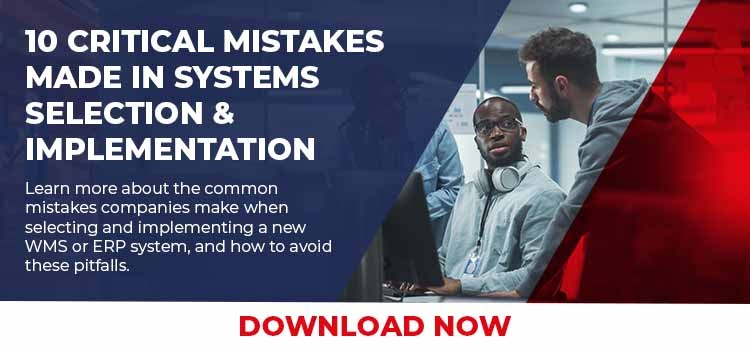Warehouse Management Systems (WMS) have become more affordable for small to moderate sized e-commerce, retail, and wholesale distribution businesses through utilizing the cloud and Software as a Service models.
Read "Is a WMS Right For Your Business?"
However, you still need to use a methodology to select the right system for your business with your budget. Short cut the process and you may select the wrong warehouse management system or it may cost you more than you think. Here are 10 things to consider to successfully select the best WMS system.
The Process and Requirements
1. Form a project team
Select a project manager with operations knowledge. Management should also appoint a sponsor that can help gain needed decisions from decision makers.
2. Define requirements
Here are some functional areas to consider. You should not have a WMS vendor write the requirements for you to save money. Your own internal requirements document will have hundreds of points to compare WMS vendors and systems against each other:
- Interface to ERP or OMS
Which are standard interfaces versus custom interfaces? What is the detailed data being exchanged between the systems? - Receiving, quality assurance, put away
Do you blind receive inbound POs? Is directed put away required? Will you require lot or expiration tracking to be captured at receipt? - Inventory
One of the major benefits to WMS is the “four walls” tracking of inventory, including tracking and auditing, SKU velocity and analysis, bin management, cycle counting, etc. - Kitting and Work Order Processing
Do you kit on the fly or pre build kits? How many levels of assembly are tracked with units and cost? Do you require kitting to be a true Work Order process? - Slotting
Not all WMS have robust slotting functionality, are you looking for a complete module that suggests moves or just the tools to support your own analysis? - Multi-warehouse
What business rules for multi-facility inventory and split shipment of customer orders are required? - Automation support
What MHE and automation interfaces/integration are required (e.g. pick to light, put to light, sortation, etc.? Will you be integrating to a separate WES or WCS system? - Shipping systems
Will you be rate shopping across multiple carriers? Do you require small parcel and LTL carrier support?
Download our FREE WMS Tech Report - Learn how you can determine the true benefits of a WMS, and some of the high level requirements and functionality per department that you should be looking for.
3. Vendor short list
Perform preliminary research for 4 or 5 qualified WMS software vendors based on functionality and costs. We advise against sending your detailed requirements to dozens of vendors, but rather the prequalified shortlist.
4. Write a detailed request for proposal
In addition to requirements, request pricing (e.g. licenses, services, equipment, annual support, etc.) Also request the vendor’s methodology, agreements, references, etc. Gain sign off from your organization on the RFP, then send the RFP to the WMS vendor short list.
5. Analyze vendor responses
Review the responses to your RFP, and select the best 2 to possibly 3 vendors to schedule software demos. Put together a detailed list of what functionality you want to see in the demo and send these to the vendor in advance so they can prepare.
6. Pick preliminary finalists
Based on the vendor demos and final pricing, select your preferred WMS vendor that you see as being the best fit for your operations.
7. Perform reference calls and site visits
It is important to not short cut the final due diligence steps, these include reference calls as well as a potential site visit. Connect with the provided references as well as others that were not provided but are known to be users of the system. Ensure that you ask the references if they finished their install on time and on budget. You will also want to know if they are achieving the goals that they expected to gain from the new WMS.
8. Start project planning
Before you make the final selection, discuss the implementation methodology and determine your responsibilities. Who will be your internal project manager? Don’t leave all PM duties to your preferred WMS vendor.
9. Return on investment
What are the areas of savings and intangibles that you can expect? The major savings we see are from better direct and indirect labor use; inventory tracking throughout the enterprise and all processes; better utilization of distribution center space through inventory management and slotting, etc. Each company must determine where the benefits are within their operations.
10. Legal review
Have an intellectual property attorney review the various contracts including user licenses, annual support agreements, 3rd party hardware/software licenses and support agreements.





SHARE